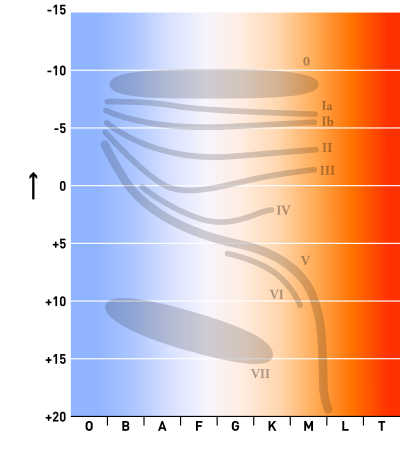
Back نجم أزرق فائق العملقة Arabic Superxigante azul AST নীল অতিদানব তারা Bengali/Bangla Supergegant blau Catalan Modrý veleobr Czech Сенкер вышкайсăр гигант CV Blua supergiganto Esperanto Supergigante azul Spanish Supererraldoi urdin Basque ابرغول آبی Persian
A blue supergiant (BSG) is a hot, luminous star, often referred to as an OB supergiant. They are usually considered to be those with luminosity class I and spectral class B9 or earlier,[1] although sometimes A-class supergiants are also deemed blue supergiants.[2][3][4]
Blue supergiants are found towards the top left of the Hertzsprung–Russell diagram, above and to the right of the main sequence. By analogy to the red giant branch for low-mass stars, this region is also called the blue giant branch.[2] They are larger than the Sun but smaller than a red supergiant, with surface temperatures of 10,000–50,000 K and luminosities from about 10,000 to a million times that of the Sun. They are most often an evolutionary phase between high-mass, hydrogen-fusing main-sequence stars and helium-fusing red supergiants,[4][5][6] although new research suggests they could be the result of stellar mergers.[7][8]
The majority of supergiants are also blue (B-type) supergiants; blue supergiants from classes O9.5 to B2 are even more common than their main sequence counterparts.[9] More post-main-sequence blue supergiants are observed than what is expected from theoretical models, which expect blue supergiants to be short-lived. This results in the blue supergiant problem, although unusual stellar interiors (such as hotter blue supergiants having oversized hydrogen-fusing cores and cooler ones having undersized helium-fusing cores) may explain this.[10]
- ^ Massey, P.; Puls, J.; Pauldrach, A. W. A.; Bresolin, F.; Kudritzki, R. P.; Simon, T. (2005). "The Physical Properties and Effective Temperature Scale of O-Type Stars as a Function of Metallicity. II. Analysis of 20 More Magellanic Cloud Stars and Results from the Complete Sample". The Astrophysical Journal. 627 (1): 477–519. arXiv:astro-ph/0503464. Bibcode:2005ApJ...627..477M. doi:10.1086/430417. S2CID 18172086.
- ^ a b Yüce, Kutluay (2005-01-01). "Spectral Analysis of 4 Lacertae and ν Cephei". Baltic Astronomy. 14: 51–82. Bibcode:2005BaltA..14...51Y. ISSN 1021-6766.
- ^ Burgos, A. de; Simon-Díaz, S.; Lennon, D. J.; Dorda, R.; Negueruela, I.; Urbaneja, M. A.; Patrick, L. R.; Herrero, A. (2020-11-01). "High-resolution spectroscopic study of massive blue and red supergiants in Perseus OB1 - I. Definition of the sample, membership, and kinematics". Astronomy & Astrophysics. 643: A116. arXiv:2008.13299. Bibcode:2020A&A...643A.116D. doi:10.1051/0004-6361/202039019. ISSN 0004-6361.
- ^ a b Wagle, Gururaj A.; Ray, Alak; Raghu, Adarsh (May 2020). "Type IIP Supernova Progenitors. III. Blue to Red Supergiant Ratio in Low-metallicity Models with Convective Overshoot". The Astrophysical Journal. 894 (2): 118. arXiv:2004.14419. Bibcode:2020ApJ...894..118W. doi:10.3847/1538-4357/ab8bd5. ISSN 0004-637X.
- ^ Gordon, Michael S.; Humphreys, Roberta M. (December 2019). "Red Supergiants, Yellow Hypergiants, and Post-RSG Evolution". Galaxies. 7 (4): 92. arXiv:2009.05153. Bibcode:2019Galax...7...92G. doi:10.3390/galaxies7040092. ISSN 2075-4434.
- ^ Vamvatira-Nakou, C.; Hutsemékers, D.; Royer, P.; Nazé, Y.; Magain, P.; Exter, K.; Waelkens, C.; Groenewegen, M. a. T. (2013-09-01). "Herschel imaging and spectroscopy of the nebula around the luminous blue variable star WRAY 15-751". Astronomy & Astrophysics. 557: A20. arXiv:1307.0759. Bibcode:2013A&A...557A..20V. doi:10.1051/0004-6361/201321853. ISSN 0004-6361.
- ^ Menon, Athira; Ercolino, Andrea; Urbaneja, Miguel A.; Lennon, Daniel J.; Herrero, Artemio; Hirai, Ryosuke; Langer, Norbert; Schootemeijer, Abel; Chatzopoulos, Emmanouil; Frank, Juhan; Shiber, Sagiv (March 2024). "Evidence for Evolved Stellar Binary Mergers in Observed B-type Blue Supergiants". The Astrophysical Journal Letters. 963 (2): L42. Bibcode:2024ApJ...963L..42M. doi:10.3847/2041-8213/ad2074. ISSN 2041-8205.
- ^ Cite error: The named reference
:1was invoked but never defined (see the help page). - ^ Sowell, J. R.; Trippe, M.; Caballero-Nieves, S. M.; Houk, N. (2007-07-18). "H-R Diagrams Based on the HD Stars in the Michigan Spectral Catalogue and the Hipparcos Catalog". The Astronomical Journal. 134 (3): 1089. Bibcode:2007AJ....134.1089S. doi:10.1086/520060. ISSN 1538-3881.
- ^ Bellinger, Earl Patrick; de Mink, Selma E.; van Rossem, Walter E.; Justham, Stephen (2024). "The Potential of Asteroseismology to Resolve the Blue Supergiant Problem". The Astrophysical Journal. 967 (2): L39. arXiv:2311.00038. Bibcode:2024ApJ...967L..39B. doi:10.3847/2041-8213/ad4990.
